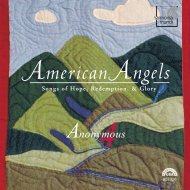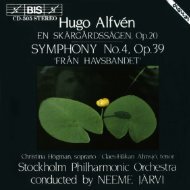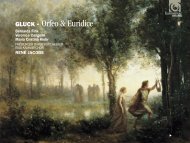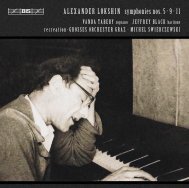NIELSEN THE SYMPHONIES - eClassical
NIELSEN THE SYMPHONIES - eClassical
NIELSEN THE SYMPHONIES - eClassical
Create successful ePaper yourself
Turn your PDF publications into a flip-book with our unique Google optimized e-Paper software.
Carl Nielsen began his Symphony No. 5 in October 1920 and the first of the<br />
two movements of this symphony was completed about 1st March 1921. Short -<br />
ly thereafter, however, Nielsen was obliged to put aside the symphony to con -<br />
cen trate on a choral commission which resulted in Springtime in Funen. It was<br />
only at the beginning of November, when he went to Gothenburg to conduct<br />
nine concerts between 13th November and 11th December, that he was able to<br />
concentrate on his symphony: ‘I shall have time for my symphony during the<br />
periods when I am not conducting and I am entirely free from dinner invita -<br />
tions… This is the most difficult task that I have confronted myself with so far<br />
and so it goes only rather slowly.’<br />
There was no subtitle to the new symphony of the sort that had graced the<br />
previous three symphonies, but in his pencil score Nielsen had noted the motto<br />
‘Dark, resting forces / Wakened forces’. In an interview published in the news -<br />
paper Politiken on the same day as the first performance, Nielsen explained his<br />
reasons for the unconventional form of the symphony and also made use of the<br />
motto: ‘My First Symphony was also unnamed. But then came “The Four Tem -<br />
peraments”, “Espansiva” and “The Inextinguishable”, which are all really just<br />
different names for the only thing that music can actually give expression to:<br />
the resting forces in opposition to the active ones… This time I have arranged<br />
things so that I have divided the symphony into two extended, broad parts, the<br />
first of which begins slowly and calmly, whilst the second is more active.’<br />
The critics were entirely positive and Nielsen seems to have been very happy<br />
with the performance. On 8th March of the same year he gave a second per for -<br />
mance of the symphony in Gothenburg, and on 1st December he conducted it<br />
once again, this time in the Beethoven Hall in Berlin with the Berlin Philhar monic<br />
Orchestra. The symphony also formed part of the programme for a con cert in<br />
Paris in October 1926, at which Ravel was present. One can only speculate as to<br />
12

















